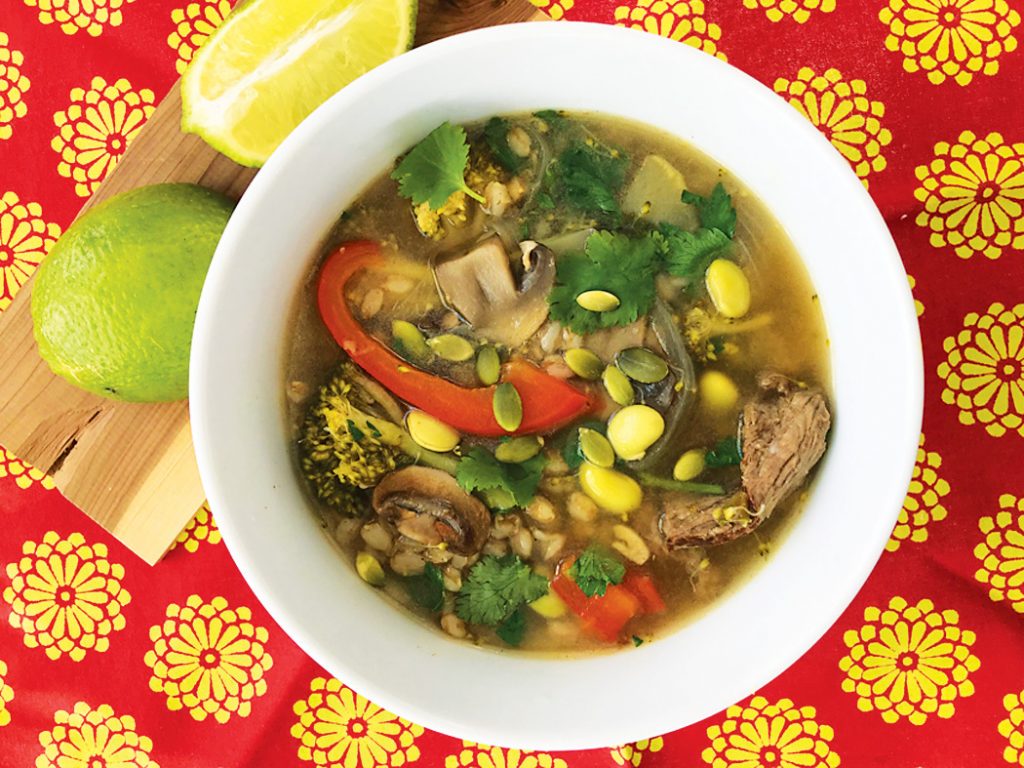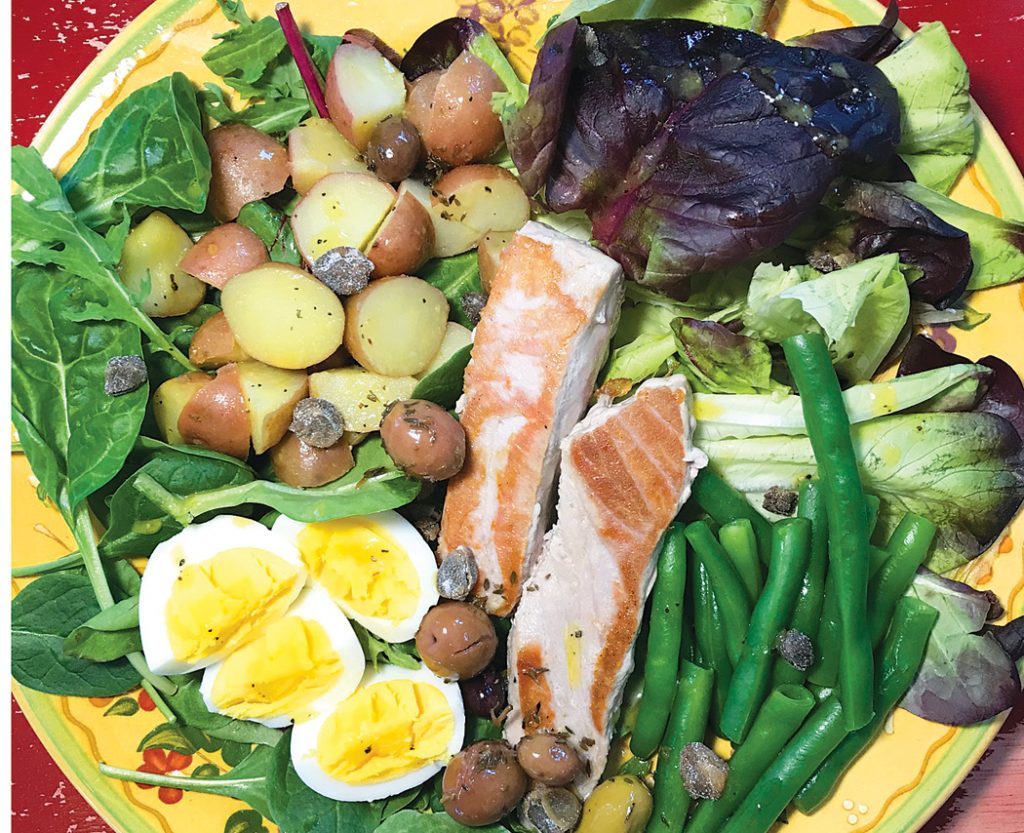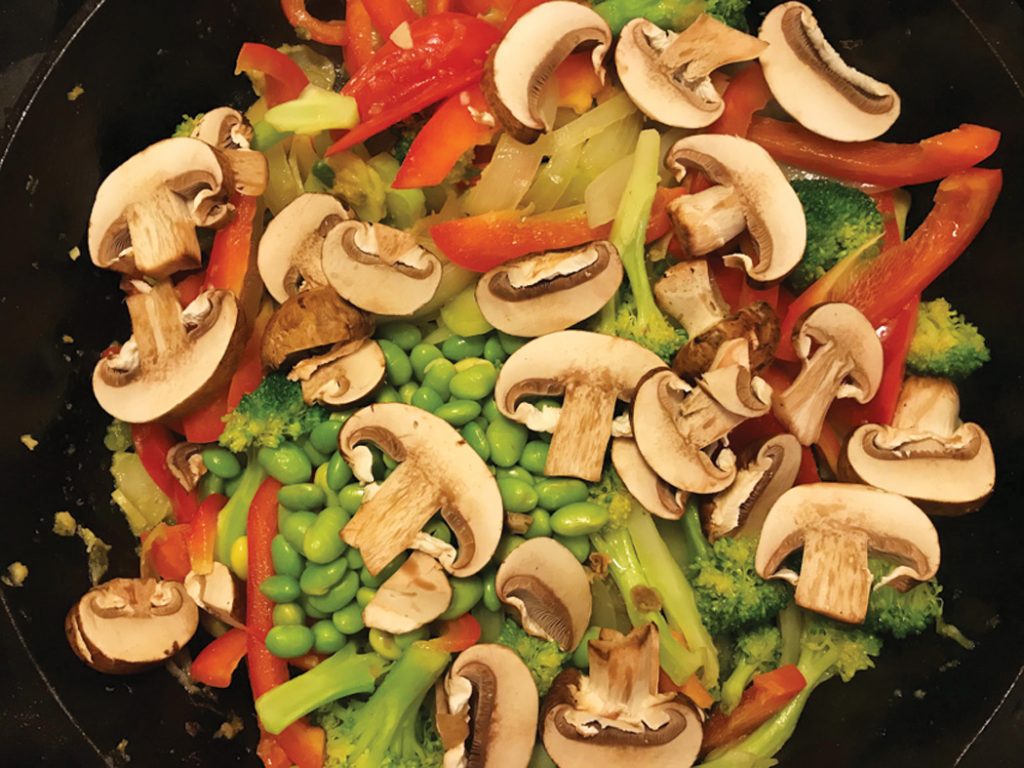
You hear it—and read it—more and more these days: A healthy immune system begins in the gut. “Get some diverse microorganisms to set up shop in your digestive tract and your body is better prepared to ward off a world of ills!” I buy it. Which is why I continue to eat food that’s fallen on the floor.
If I feel a sniffle coming on, or my mother is nervous that I just went into the hardware store again where customers seem to prefer a mask-free fashion statement, my running joke is, “Don’t worry, Mom, I’ll just go lick a dog.” The bacteria on a filthy, freshly walked dog surely will replenish the gut microbia I killed off last night with my bad-fat, high-sugar, no-fiber pizza-n-Coke dinner à la the corner gas station.
Instead of licking dogs, maybe she should try licking some better food, you’re thinking. You are so smart! And telepathic, to boot. Eating real food is an especially relevant point, given that—based on my age, line of work, and shoe size—I’m not going to qualify for a coronavirus vaccine until 2037.
The Strategy
Browsing a broad swath of sensational articles on laying out the red carpet for “good” bacteria—and on improving my immune system in general, I decided it would be a riotous challenge to cram as many “TOP TEN MUST EAT!” immune-boosting ingredients as possible into a day’s worth of righteous recipes.
I was initially going to jam them all into one meal and call it the “Super Supper of Immortality!” But we want our bodies to be bursting with our new nutrient buddies—not the seams of our pants. Besides, my mega list of immune-boosting ingredients began sorting itself nicely into a few different culinary categories: Today we shall nod to French(ish), vaguely Asian, and New-Age Hippie traditions in a breakfast, lunch, and dinner for winners.
In addition to being rich in vitamin C, D, E, zinc, probiotics, or prebiotic fiber to feed that microbiome, my list of superfoods turned out to be delightfully colorful. Every nature-derived hue has unique immune-modulating properties, so it only makes sense that dancing a tango of deeply colored ingredients will help a body fire on all cylinders. Join me in ditching the pale-food polka.
You’re used to hearing “eat your fruits and vegetables,” but squeezing in a probiotic food every day can be trickier, especially if you’re feeding the younger, whinier members of your family. (Pickled cabbage—what every kid wants for dinner!) Luckily, you have a few more options than that, most of which start with the letter K. Pure coincidence.
Kraut, kimchi, kombucha, kefir. These are all funkified probiotic foods you can theoretically make from scratch, but that’s a lot of flippin’ work. You have to be equipped with starters, cultures, jars, mesh cloths, 500-pound crocks, an assortment of weights and springs, blah blah blah, and I’m just not there yet. Plus, the idea of fermenting my own food gives me the heebie jeebies.
I can only handle sauerkraut from the refrigerated section of the local whole foodery about once a month, and the endless brands of attractively bottled kombucha all smell like athlete’s foot to me. That said, I am not at all averse to the frothy tang of kefir. These days, you can find this yogurty beverage made from all kinds of dairy and nondairy foodstuffs and in flavors ranging from mango to blackberry. Now you’re talking my language.
Time for Breakfast
You might think I’m nuts for putting these ingredients together, but this lightly sweet slurper with real zing and a satisfying crunch-top kept me full-bellied and energized for the entire three hours I spent Shop-Vac-ing my basement. My body wanted a repeat experience the next day. Of the kefir, not the Shop-Vac-ing.
Sip, chew, and enjoy this golden smoothie as a breakfast or mid-afternoon snack. It’s even better if you can imbibe it in the sun for some ultimate vitamin D absorption through your skin-suit. Weather allowing.
Nutty Sunshine Kefir
(serves 2)
2 c. cashew milk kefir (probiotic, plus cashews have prebiotic fiber)
1 ripe banana (prebiotic fiber, vitamin C)
4 Tbsp. organic ginger juice (anti-inflammatory, antioxidant)
½ tsp. turmeric (anti-inflammatory, antioxidant)
Generous pinch of slivered almonds (vitamin E, zinc, prebiotic fiber)
Blend the kefir, banana (pre-mushed with a fork if it’s not very ripe yet), ginger juice, and turmeric on high until combined and frothy. Pour into a purdy glass and top with almond slivers.
Tips: If you don’t own a juicer, you can blend a small chunk of organic ginger with equal parts water, then strain or squeeze through a mesh cloth. Use any leftovers to make a zippy salad dressing or use the pulp to make a tea! Your grocer might also carry ginger juice.
Also, if the earthy flavor of turmeric doesn’t do it for you, you could substitute cinnamon, another anti-inflammatory antioxidant. Wild blueberries also give it a nice flavor and a vitamin C and antioxidant boost, though they’ll muddy up the golden color. If you care about that kind of thing.
Let’s Munch on Lunch
I’ve been craving this dish for literally decades; it’s hard to find on menus around here. Though rich in protein and Omega-3 fatty acids, this salad makes for lighter fare for easy digestion, and it’s a great dish as we begin breezing into some warmer weather. Citrusy, savory, satisfying, it’ll send you sailing into your afternoon. You may even be inspired to get up and dance.
For this one, I really wanted to zero in on vitamin D, which helps regulate the immune system and is thought to boost the body’s natural defenses against COVID-19. The flesh of fatty fish (who doesn’t love a good fat fish?) is among the best food sources of D. The egg yolks will help too if those chickens had access to the great outdoors.

Mustard Lovers’ Salmon Niçoise
(serves 3)
Dressing
1/ 3 c. extra virgin olive oil (anti-inflammatory, possible cancer inhibitor)
2 Tbsp. fresh lemon juice (vitamin C)
1 Tbsp. Dijon mustard (myriad nutritional benefits!)
½ tsp. honey (prebiotic)
½ tsp. freshly ground black pepper (antioxidant)
½ tsp. sea salt, plus a little more
Salad
3 oz. spinach or mixed greens (I like the baby kale, spinach, chard power greens mix I found) (vitamin C & A, antioxidants, beta carotene)
16 oz. salmon fillet, tuna steak, or 1½ cans tuna (vitamin D)
3 large eggs (vitamin D)
8 oz. green beans (vitamin C)
8 oz. red new potatoes (30 percent of your daily vitamin C, more potassium than a banana!)
2–3 tsp. capers (contains quercetin, a powerful antioxidant, anti-inflammatory)
1/ 3 c. of your favorite olives (most boast polyphenols, an immune-system booster, vitamins E & C)
1 Tbsp. yellow mustard (more turmeric!)
1 Tbsp. olive oil
1 tsp. sea salt
For the dressing, whisk together (or shake in a jar) the olive oil, lemon juice, mustard, honey, pepper, and ½ tsp. salt. Set aside. (Can be made up to 5 days ahead.)
Bring a medium pot of salted water (about 1 tsp. salt) to a boil. Gently add eggs and cook seven minutes, then transfer to iced water with a slotted spoon; chill until cold.
Using the same pot of salt water over high heat, add the green beans and potatoes and cook until tender (about 3 minutes for green beans, 10–12 minutes for potatoes). With a slotted spoon, transfer to bowl of ice water, let cool for 3 minutes, then move to a towel and pat dry. Cut the new potatoes in half.
If you are using salmon steak, my favorite choice, preheat the oven to 425° and place the fillet(s) on a baking sheet or pan greased with a little olive oil. Brush each fillet with olive oil, then add a dollop of yellow mustard on top, spreading evenly with the back of a spoon. Cook near the top rack about 12 minutes (9–10 minutes per inch of height is a decent rule of thumb), or until pink is about gone from the center. For a nice scald on the mustard, move to the very top rack for another 2 minutes, then remove from oven.
To serve, peel eggs and slice in halves or quarters and arrange with the beans, potatoes, and fish in neat sections over the greens. Top with olives and capers, sprinkle with sea salt, and drizzle with dressing. Serve with the remaining dressing alongside.
Tips: If the “stank” of raw, unpasteurized apple cider vinegar doesn’t turn your stomach, you could try a little in the dressing for extra live enzymes. This stuff is strong, so start with a few drops and go from there. I’d hate for you to ruin a beautiful plate of food.
When they’re in season, you could also add a couple juicy tomatoes for more vitamin C, and bump up the superfoods quotient with watercress or dandelion greens if you’re up for a spicier forkful.

Now for Dinner
I’ve discovered I really do prefer to chew my soup instead of drink it. And I’ve always considered the hot ’n’ sour combo used in Asian and Mexican soups to be the absolute bomb. Special thanks to Chef Sean Hickey for his help in making this recipe come together. Hey, Sean, you wok. I mean rock.
Spicy Lime & Beef Miso Soup
(serves 8)
1″ segment ginger root, peeled and coarsely grated (anti-inflammatory, used for nausea)
2 cloves garlic, sliced thin (anti-inflammatory, used for chronic pain and nausea)
1 medium onion, cut into strips, pole to pole (vitamin C, anti-inflammatory)
½ jalapeno pepper, seeded and deveined (activates the circulatory system, helps fight infection)
2 Tbsp. olive oil (anti-inflammatory, possible cancer inhibitor)
½ head broccoli, cut into florets, stem peeled and sliced thin (vitamin C, cancer-fighting superfood)
1 red bell pepper, cut into strips (3 times the vitamin C of an orange)
8 oz. mushrooms, wild or grown with UV, cleaned and sliced (vitamin D, zinc)
2 c. cooked farro (fiber-rich ancient grain with antioxidants)
½ c. edamame, shelled and thawed (nutrient-rich prebiotic)
12 oz. New York strip or flank beefsteak (zinc, protein)
2 quarts chicken or veggie stock (hydrating, anti-inflammatory)
1 rounded Tbsp. white miso (probiotic)
¼ cup pumpkin seeds (zinc, vitamins, and minerals)
10–12 leaves Thai basil, if you can find it (anti-inflammatory, antibacterial, used for the common cold and more)
1 c. fresh cilantro (vitamins A, C, K)
2 large limes (vitamin C)
1½ tsp. salt (or to taste)
½ tsp. white pepper (or to taste)
½ tsp. black pepper (antioxidant, anti-inflammatory)
Dash of cayenne (pro-circulatory)
Vegetarian Version: Skip the steak, double the edamame
Season the beefsteak on both sides with salt and ground black pepper, then sear on high heat 3 minutes each side. Slice into strips, set aside.
In a large wok or fry pan, sauté the aromatics (ginger, garlic, onion, jalapeno) in olive oil on medium-low heat. After they “bloom” in fragrance, stir in the miso. Next, add vegetables in order of hard to soft: broccoli, red bell pepper, mushrooms, edamame. Sauté until slightly softened. Spoon in a splash of water to encourage some steam cooking if you want. (I like my veggies al dente for a more brilliant color.) Incorporate the cooked steak slices.
Add the stock, bring to a boil, then salt and pepper to taste. Add the juice of a large lime, stir, and serve. Garnish in the bowl with fresh herbs, the pumpkin seeds, and another wedge of lime.
If, like me, you can handle more heat than your eating partner, a sprinkle of cayenne will bring on a satisfying nose drip without messing with the flavor. I was so happy with this soup I almost cried.
Tips: If you can’t find Thai basil, use any fresh basil or flat leaf parsley.
The Evening Sipper
Lastly, for a warming evening treat, make yourself a nice Elderberry Echinacea tea, the ultimate immune-boosting combo. Create your own or buy it in a box, because you’ve had a big day. Sip with your feet up while enjoying the other best medicine known to man: an episode of The Joy of Painting with Bob Ross.
The happy little smile that spreads across your happy little face is filling your happy little brain with endorphins, the neurotransmitters associated with lowering stress and anxiety. What a nice button to your day’s adventures in eating the rainbow and turning yourself into an immortal God.
Disclaimer. This author is neither a health expert nor nutritionist and cannot guarantee any of the benefits touted above. But at the very least you can enjoy what the body feels like after imbibing a day’s worth of nutrient-rich whole foods with almost no processed ingredients or added sugars! At the very worst, you’ll be a little gassier than normal.
